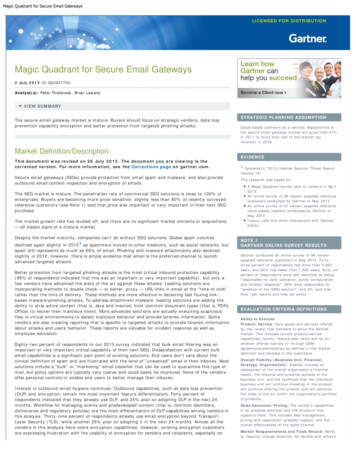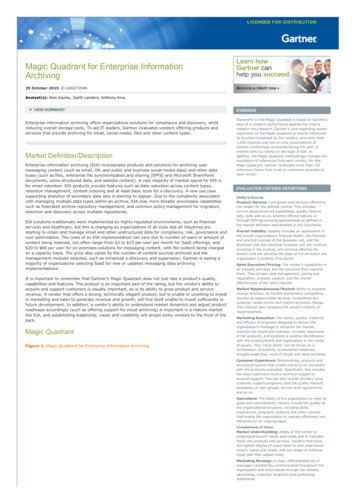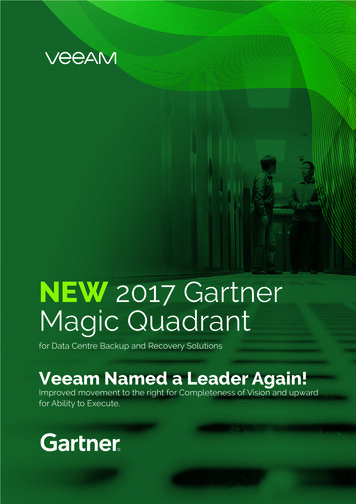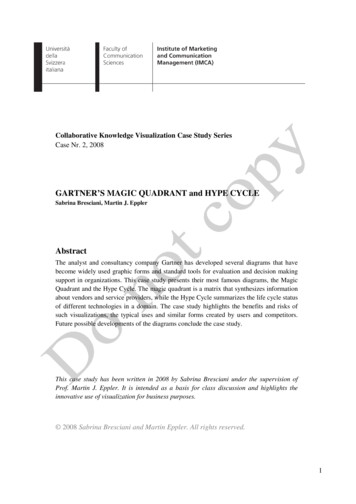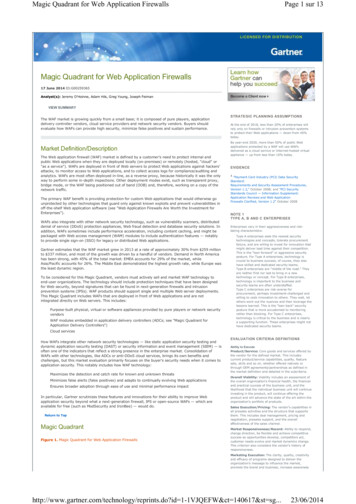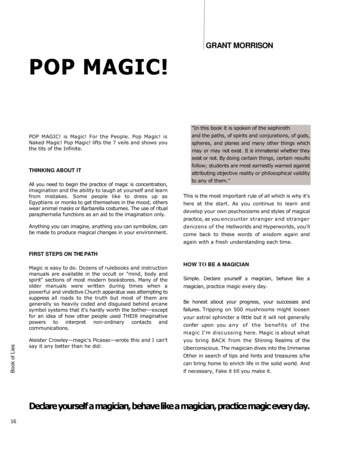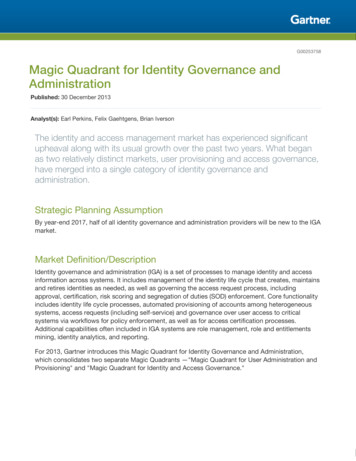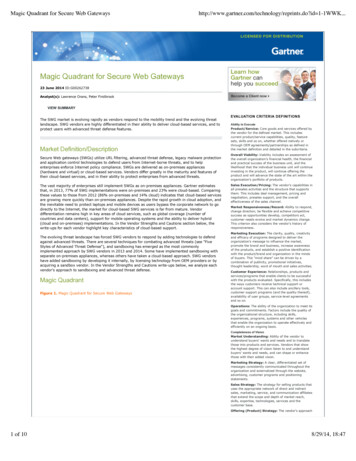
Transcription
Magic Quadrant for Secure Web .do?id 1-1WWK.Magic Quadrant for Secure Web Gateways23 June 2014 ID:G00262738Analyst(s): Lawrence Orans, Peter FirstbrookVIEW SUMMARYThe SWG market is evolving rapidly as vendors respond to the mobility trend and the evolving threatlandscape. SWG vendors are highly differentiated in their ability to deliver cloud-based services, and toprotect users with advanced threat defense features.Market Definition/DescriptionSecure Web gateways (SWGs) utilize URL filtering, advanced threat defense, legacy malware protectionand application control technologies to defend users from Internet-borne threats, and to helpenterprises enforce Internet policy compliance. SWGs are delivered as on-premises appliances(hardware and virtual) or cloud-based services. Vendors differ greatly in the maturity and features oftheir cloud-based services, and in their ability to protect enterprises from advanced threats.The vast majority of enterprises still implement SWGs as on-premises appliances. Gartner estimatesthat, in 2013, 77% of SWG implementations were on-premises and 23% were cloud-based. Comparingthese values to those from 2012 (86% on-premises and 14% cloud) indicates that cloud-based servicesare growing more quickly than on-premises appliances. Despite the rapid growth in cloud adoption, andthe inevitable need to protect laptops and mobile devices as users bypass the corporate network to godirectly to the Internet, the market for cloud-based SWG services is far from mature. Vendordifferentiation remains high in key areas of cloud services, such as global coverage (number ofcountries and data centers), support for mobile operating systems and the ability to deliver hybrid(cloud and on-premises) implementations. In the Vendor Strengths and Cautions section below, thewrite-ups for each vendor highlight key characteristics of cloud-based support.The evolving threat landscape has forced SWG vendors to respond by adding technologies to defendagainst advanced threats. There are several techniques for combating advanced threats (see "FiveStyles of Advanced Threat Defense"), and sandboxing has emerged as the most commonlyimplemented approach by SWG vendors in 2013 and 2014. Some have implemented sandboxing withseparate on-premises appliances, whereas others have taken a cloud-based approach. SWG vendorshave added sandboxing by developing it internally, by licensing technology from OEM providers or byacquiring a sandbox vendor. In the Vendor Strengths and Cautions write-ups below, we analyze eachvendor's approach to sandboxing and advanced threat defense.Magic QuadrantFigure 1. Magic Quadrant for Secure Web GatewaysEVALUATION CRITERIA DEFINITIONSAbility to ExecuteProduct/Service: Core goods and services offered bythe vendor for the defined market. This includescurrent product/service capabilities, quality, featuresets, skills and so on, whether offered natively orthrough OEM agreements/partnerships as defined inthe market definition and detailed in the subcriteria.Overall Viability: Viability includes an assessment ofthe overall organization's financial health, the financialand practical success of the business unit, and thelikelihood that the individual business unit will continueinvesting in the product, will continue offering theproduct and will advance the state of the art within theorganization's portfolio of products.Sales Execution/Pricing: The vendor's capabilities inall presales activities and the structure that supportsthem. This includes deal management, pricing andnegotiation, presales support, and the overalleffectiveness of the sales channel.Market Responsiveness/Record: Ability to respond,change direction, be flexible and achieve competitivesuccess as opportunities develop, competitors act,customer needs evolve and market dynamics change.This criterion also considers the vendor's history ofresponsiveness.Marketing Execution: The clarity, quality, creativityand efficacy of programs designed to deliver theorganization's message to influence the market,promote the brand and business, increase awarenessof the products, and establish a positive identificationwith the product/brand and organization in the mindsof buyers. This "mind share" can be driven by acombination of publicity, promotional initiatives,thought leadership, word of mouth and sales activities.Customer Experience: Relationships, products andservices/programs that enable clients to be successfulwith the products evaluated. Specifically, this includesthe ways customers receive technical support oraccount support. This can also include ancillary tools,customer support programs (and the quality thereof),availability of user groups, service-level agreementsand so on.Operations: The ability of the organization to meet itsgoals and commitments. Factors include the quality ofthe organizational structure, including skills,experiences, programs, systems and other vehiclesthat enable the organization to operate effectively andefficiently on an ongoing basis.Completeness of VisionMarket Understanding: Ability of the vendor tounderstand buyers' wants and needs and to translatethose into products and services. Vendors that showthe highest degree of vision listen to and understandbuyers' wants and needs, and can shape or enhancethose with their added vision.Marketing Strategy: A clear, differentiated set ofmessages consistently communicated throughout theorganization and externalized through the website,advertising, customer programs and positioningstatements.Sales Strategy: The strategy for selling products thatuses the appropriate network of direct and indirectsales, marketing, service, and communication affiliatesthat extend the scope and depth of market reach,skills, expertise, technologies, services and thecustomer base.Offering (Product) Strategy: The vendor's approach1 of 108/29/14, 18:47
Magic Quadrant for Secure Web .do?id 1-1WWK.to product development and delivery that emphasizesdifferentiation, functionality, methodology and featuresets as they map to current and future requirements.Business Model: The soundness and logic of thevendor's underlying business proposition.Vertical/Industry Strategy: The vendor's strategyto direct resources, skills and offerings to meet thespecific needs of individual market segments, includingvertical markets.Innovation: Direct, related, complementary andsynergistic layouts of resources, expertise or capital forinvestment, consolidation, defensive or pre-emptivepurposes.Geographic Strategy: The vendor's strategy to directresources, skills and offerings to meet the specificneeds of geographies outside the "home" or nativegeography, either directly or through partners,channels and subsidiaries as appropriate for thatgeography and market.Source: Gartner (June 2014)Vendor Strengths and CautionsBarracuda NetworksBarracuda offers the Barracuda Web Filter appliances and the cloud-based Barracuda Web SecurityService. Barracuda customers typically implement its appliances in transparent bridge mode to view allnetwork traffic, but the appliances can also be implemented in proxy mode. In 2013, Barracuda gaineda new CEO; later that November, it launched an initial public offering (IPO) and became a publiclytraded company. In 2014, Barracuda agreed to license Lastline's cloud-based sandbox technology.Barracuda Web Filter appliances are good candidates for small or midsize businesses (SMBs) andcost-conscious enterprises.StrengthsBarracuda offers a low-cost solution that is easy to use with competitive functionality. Thevendor's Instant Replacement program, which provides next-business-day shipping ofreplacement units, includes a free appliance replacement unit every four years.Application control is strong. In-line deployments of Barracuda's SWG enable it to filter all portsand protocols. Features include granular social media controls and social media archiving.Barracuda provides a free, lightweight mobile data management (MDM) capability to simplify themanagement of policies on mobile devices running Apple iOS and Android.Partnerships with wireless vendors Meru and Ruckus Wireless enable single sign-on (SSO). Whena user authenticates to a Ruckus or Meru access point, the user's credentials are shared with theBarracuda SWG. The user's activity can be monitored on the Internet, without requiring the userto authenticate directly to Barracuda's SWG.CautionsThe cloud-based service is missing a number of enterprise features. For example, it lacks IPsecsupport for traffic redirection, and it does not inspect Secure Sockets Layer (SSL) traffic.Barracuda's integration with Lastline is in its initial phases, and is not yet tightly integrated. Theinitial integration lacks the ability to defend against targeted attacks (although it does improveBarracuda's ability to defend against zero-day threats).Barracuda's advanced threat defense strategy is heavily dependent on the technology that it haslicensed from Lastline, which is a small company. If Lastline's status changes, then Barracuda mayneed to revisit its advanced threat strategy.Blue Coat SystemsBlue Coat was acquired by private equity firm Thoma Bravo in February 2012. Since the acquisition,Blue Coat acquired several security companies, including Netronome (SSL appliances) in May 2013,2 of 108/29/14, 18:47
Magic Quadrant for Secure Web .do?id 1-1WWK.Solera Networks (full packet capture for network forensics) in May 2013 and Norman Shark(appliance-based sandbox) in December 2013. Blue Coat also introduced the Content Analysis System(CAS), an internally developed malware detection appliance that analyzes traffic forwarded to it by BlueCoat's ProxySG. In addition to its appliance-based offerings, Blue Coat offers a cloud-based SWGservice. Blue Coat's appliances are good candidates for most large-enterprise customers, particularlythose requiring highly scalable SWGs. Blue Coat's cloud service is a good option for most enterprises.StrengthsThe ProxySG is the strongest proxy in the market in terms of breadth of protocols and the numberof advanced features. It supports a broad set of protocols as well as extensive authentication anddirectory integration options.Blue Coat has made good progress in integrating the products that it has acquired. For example,its CAS can automatically deposit suspicious files in the Malware Analysis Appliance (sandbox).The CAS also integrates with FireEye's Web Malware Protection System (MPS; however, the CASdoes not yet integrate with FireEye's NX series, which is the updated version of the MPS).The Security Analytics solution (Solera Networks technology) integrates with the Malware AnalysisAppliance (Norman Shark technology) and provides a forensic analysis of packets associated witha suspicious file.Blue Coat's cloud offering includes multitenant IPsec gateways, which enable it to support a widerange of mobile devices. Blue Coat agents are available for Windows, Mac OS X, Apple iOS andAndroid.CautionsBecause Blue Coat's advanced threat defense solution requires multiple components, it isexpensive. The ProxySG does not deposit suspicious files in the Malware Analysis Appliance.Customers must purchase the CAS if they want to automatically detect suspicious files andanalyze them in the Malware Analysis Appliance.Blue Coat's hybrid implementation of its cloud and on-premises offerings is incomplete. Policysynchronization is not bidirectional (it supports synchronization only from the cloud to on-premisesappliances). Downloading logs from the cloud to on-premises appliances can be scheduled onlyhourly.Blue Coat's Reporter application lacks severity indicators for prioritizing alerts.CiscoCisco offers the appliance-based Web Security Appliance (WSA) and the cloud-based Cloud WebSecurity (CWS) service. The WSAs are implemented as proxies. In October 2013, Cisco completed itsacquisition of Sourcefire; in May 2014, it announced its intent to acquire ThreatGRID, whose primaryoffering is a cloud-based sandboxing service. In February 2014, Cisco announced its cloud-basedCognitive Threat Analytics (CTA) feature, based on technology from its acquisition of Cognitive Securityin February 2013. Cisco's WSA products are good options for most midsize and large enterprises, whilethe CWS service is a good option for most enterprises.StrengthsCisco has integrated a traffic redirection feature — a critical component of any cloud service —into some of its on-premises equipment. The ASA firewall, Integrated Services Router (ISR)Generation 2 and WSA all support Cisco's "connector" software, which directs traffic to the CWSservice. Traffic redirection is enabled via a menu item when configuring these appliances.Mobile platform support is a strength of the CWS service for customers that have alreadyimplemented Cisco's popular AnyConnect client. The cloud service supports Windows, Mac OS X,Apple iOS, Android, Windows Phone 8 and BlackBerry.Sourcefire's Advanced Malware Protection (AMP) technology is available as an option on Cisco'sWSA and CWS service (separate license fees apply).Cisco's intended acquisition of ThreatGRID and its sandboxing technology will complement thefile-based advanced threat defense technology that it acquired from Sourcefire. Gartner expectsthat Cisco will integrate the WSA with a ThreatGRID-based appliance (but not before 2015), sothat suspicious files can be further analyzed in a sandbox environment. The combination offile-based and sandboxing technologies should reduce false positives and improve the accuracy ofmalware and advanced threat detection.CautionsCisco has been slow to integrate its cloud-based SWG (ScanSafe acquisition of 2009) with itson-premises SWG (IronPort acquisition of 2007). Customers seeking a hybrid cloud/on-premisessolution will need two consoles. The consoles lack policy synchronization (to share policiesbetween cloud and on-premises users). Log synchronization is not configurable by the customer,but on customer request, Cisco can automate log synchronization up to four times per day.The CTA capability is not available to WSA customers. Only CWS customers can utilize the CTAfunctionality.Getting maximum value from AMP requires implementing FireAMP Connector agents on networkendpoints. The FireAMP Connectors are optional, but without them, the AMP-integrated SWGprovides reduced monitoring and investigative functionality.Cisco's cloud service has a surprisingly small global footprint (15 countries), given Cisco'sresources and the number of years it has been in the SWG market. Newer rivals have been moreaggressive in global expansion. The cloud service also lacks support for IPsec.ContentKeeper Technologies3 of 108/29/14, 18:47
Magic Quadrant for Secure Web .do?id 1-1WWK.ContentKeeper Technologies is based in Australia, where it has many large government, education andcommercial customers. It offers a family of SWG appliances that deploy in transparent bridge mode,and it also provides a hosted cloud-based service. ContentKeeper's advanced threat solutions can beimplemented on-premises or in its hosted cloud service. ContentKeeper is a good option for midsize andlarge organizations, and for K-12 schools in supported geographies.StrengthsContentKeeper has developed its own sandboxing technology, which gives it control of itsadvanced threat defense strategy by limiting its reliance on partnerships.A bring your own device (BYOD) feature enables ContentKeeper's SWG to enforce Internet accesspolicies for mobile devices and users. ContentKeeper agents and mobile apps support off-networkdevices (such as Windows, Mac OS X, Linux, iOS and Android).ContentKeeper appliances support the ability to proxy and analyze SSL traffic.CautionsContentKeeper lacks a shared, multitenant, IPsec-based cloud SWG service. It provides a hostedcloud offering, where customers run virtual appliances hosted in Amazon's cloud service (and insome ContentKeeper-managed data centers). Hosted offerings do not scale as dynamically asshared multitenant clouds.ContentKeeper has yet to earn recognition as a leading advanced threat defense company.Prospective customers should carefully test the efficacy of its advanced threat capabilities againstcompeting solutions.The lack of severity indicators on ContentKeeper's dashboard makes it difficult to prioritizemalware alerts.Outside the Asia/Pacific region, ContentKeeper has a limited value-added reseller (VAR) channel.Prospective customers should carefully vet ContentKeeper VARs to ensure that they can provideadequate local support.ibossiboss offers a family of appliance-based platforms that are typically deployed in transparent bridgemode. It also offers a cloud-based service. In 2014, iboss began offering a cloud-based advanced threatdefense service based on technology that it has licensed from Lastline. iboss is a good option formidsize and large enterprises, and for K-12 schools in supported geographies.Strengthsiboss has integrated its SWG with the cloud-based sandboxing service that it licenses fromLastline. The iboss SWG can automatically deposit suspicious objects in the sandbox, and theiboss management console displays the results of the analysis.Full SSL content inspection is provided agentless at the gateway, or with an optional agent-basedsolution on endpoints. The agent is a scalable approach that relieves the iboss appliance of theburden of managing certificates, and of terminating and decrypting SSL traffic.iboss provides lightweight MDM functionality that helps enterprises configure Apple iOS andAndroid devices to use its cloud service.Bandwidth controls are very flexible. For example, bandwidth quotas can be applied to a specificorganizational unit in Active Directory, and they can also be assigned to a specific domain.Cautionsiboss' cloud service lacks IPsec support for mobile devices, which is a common requirement formobile users (remote offices can be supported via IPsec on routers and firewalls).iboss' advanced threat detection strategy is heavily dependent on the technology that it haslicensed from Lastline, which is a small company. If Lastline's status changes, then iboss mayneed to revisit its advanced threat strategy.iboss has only a limited set of customers outside North America. As it begins a plannedinternational expansion, prospective customers outside North America should validate that ibosspartners are qualified to provide sales and technical support.Intel Security (McAfee)McAfee, which is now part of Intel Security, offers a family of on-premises SWG appliances (McAfeeWeb Gateway [MWG]) and cloud-based SWG services (SaaS Web Protection). The SWG appliances aremost commonly implemented as proxies, although they can also be deployed in other modes, includingin-line transparent bridges. In October 2013, Intel Security announced its Advanced Threat Defenseappliance, which is based on technology from its acquisition of ValidEdge in February 2013. IntelSecurity's solutions are good candidates for most enterprise customers, particularly those that arealready ePolicy Orchestrator users.StrengthsMWG has strong malware protection due to its on-box browser code emulation capabilities. Thesolution provides the ability to adjust the sensitivity of malware detection. A rule-based policyengine enables flexible policy creation.MWG integrates with the Advanced Threat Defense appliance. It automatically deposits suspiciousfiles in the sandbox for analysis.Intel Security has a good implementation of a hybrid cloud/on-premises solution. While policysynchronization is only unidirectional (from on-premises to the cloud), flexible controls enablesome policies to be synced, whereas others are not. Log file synchronization can be configured in4 of 108/29/14, 18:47
Magic Quadrant for Secure Web .do?id 1-1WWK.specified time intervals.MWG provides strong support for scanning SSL traffic. It can be configured to automaticallyenforce SSL certificate decisions and remove the decision from end users (who almost alwaysaccept unknown or expired certificates).In addition to its existing data loss prevention (DLP) support, MWG also protects sensitive datastored in public clouds from unauthorized access. It can automatically encrypt files transmitted toDropbox and other file sharing and collaboration sites, and users cannot retrieve and decrypt fileswithout going through the MWG.CautionsThe SaaS Web Protection service does not support an IPsec-based multitenant gateway, which is acommon requirement for supporting mobile devices.Intel Security's mobility strategy needs improvement. Its McAfee Client Proxy for Windows is astrong solution, but it does not offer an endpoint client for Mac OS X. Also, Intel Security lackspartnerships with MDM vendors to enforce IPsec tunnels (to SaaS Web Protection) on mobiledevices running iOS and Android.Intel Security's cloud service has a surprisingly small global footprint (12 data centers), given itsresources and the number of years it has been in the SWG market. Newer rivals have been moreaggressive in global expansion.SangforSangfor is a network equipment vendor based in China. Approximately half of its revenue comes fromits SWG products; the remaining revenue comes from its firewall, VPN, WAN optimization controllersand application delivery controller products. Sangfor's SWG comes in a hardware appliance form factor,and it is implemented as an in-line transparent bridge. The company offers two versions of its SWGproduct: one aimed at the Chinese market, and one aimed at English-speaking countries. Nearly all ofthe company's revenue comes from the Asia/Pacific region. Sangfor is a candidate for organizationsthat are based in China and in supported countries in the Asia/Pacific region.StrengthsSangfor has strong application control features. It can apply granular policies to Facebook andother Web-based applications, and it has also developed network signatures to block port-evasiveapplications like BitTorrent and Skype.A partnership with Aruba Networks enables SSO. When a user authenticates to an Aruba wirelessLAN, the user's credentials are shared with the Sangfor SWG. The user's activity can be monitoredon the Internet, without requiring the user to authenticate directly to the Sangfor SWG.Sangfor's in-line transparent bridge mode enables flexible and granular bandwidth controlcapabilities. Bandwidth utilization parameters can be specified for uplink and downlink traffic.CautionsSangfor's SWG appliance lacks advanced threat defense capabilities.Mobility is a weak spot for Sangfor because it does not offer a cloud-based SWG service.Malware detection is basic and relies on a signature-based approach. The console dashboard lacksseverity indicators to prioritize malware alerts.SophosSophos has a broad range of network gateways through native development, and from its acquisitionsof Astaro in 2011 and Cyberoam Technologies in 2014. The Sophos Web Appliance (SWA) can bedeployed in proxy or transparent in-line bridge mode. Sophos' SWG strategy is in transition. The vendoris working on integrating its stand-alone SWA functionality into its unified threat management (UTM)appliances, and it is also planning a multitenant cloud Web filtering service.StrengthsEase of use is a key design criterion for Sophos. Features include automated network anddirectory discovery, contextual help functions, and simple policy configuration.Mobile users who are running the Sophos endpoint protection platform benefit from its localon-device enforcement of the URL filtering policy, without having to forward requests to the cloud.Sophos is an established player in the malware detection market. The SWA uses Sophosdeveloped technology to perform a pre-execution analysis of all downloaded code, including binaryfiles and JavaScript.Sophos places a strong emphasis on service and support. It optionally monitors customers'appliances and provides alerts for critical hardware conditions, such as high temperatures or faultydisk drives.CautionsThe SWA should be considered a tactical solution for the near term, given Sophos' strategy totransition its SWG functionality to a new platform.Sophos lacks a multitenant cloud-based service that analyzes traffic and Web objects to detectmalware.The SWA is not integrated with a sandbox (Sophos does not offer a sandboxing solution).The console lacks severity indicators to prioritize malware alerts.5 of 108/29/14, 18:47
Magic Quadrant for Secure Web .do?id 1-1WWK.SymantecSymantec has two offerings in the SWG market: (1) the Symantec.cloud service; and (2) the SymantecWeb Gateway appliance, which may be deployed as an in-line transparent bridge, as a proxy, or inswitch port analyzer (SPAN) or test access point (TAP) mode. In May 2014, Symantec announced that itwould deliver an advanced threat protection solution that would be "generally available within the next12 months." Symantec also announced a road map of advanced threat services that it will deliver in2014. Symantec moved from the Challengers quadrant in 2013 to the Niche Players quadrant this yeardue to its slow response to the advanced threats trend, weakness in its cloud and mobile strategy, anduncertainty associated with its interim CEO's position. Symantec's SWG offerings are good options forSMBs that do not need a hybrid approach.StrengthsSymantec.cloud provides strong DLP support (a separate license is required) with the ability toconfigure flexible policies.Support for multiple languages broadens Symantec.cloud's appeal in many non-English-speakingcountries.Symantec's SWG offerings benefit from its strong malware research labs and its Insight filereputation engine.CautionsSymantec has not integrated its cloud-based SWG (MessageLabs acquisition of 2008) with itson-premises SWG (Mi5 Networks acquisition of 2009). Customers seeking a hybrid cloud/onpremises solution will need two consoles. The consoles lack policy synchronization (to sharepolicies between cloud and on-premises users) and log synchronization.If Symantec follows through on its plan to deliver an advanced threat solution "within the next 12months," then it will be about one year behind its key competitors that have solutions today. Thelate entry limits Symantec's opportunities in large enterprises, many of which have alreadyimplemented advanced threat solutions.Symantec's cloud and mobile strategy needs improvement. The cloud service does not supportIPsec, which is a common approach for supporting mobile devices. The Smart Connect agent is astrong solution for Windows endpoints, but it is not available for Mac OS X.The unresolved CEO position casts uncertainty over Symantec's strategic plans in SWGs andadvanced threat defense. At the time of this writing, Symantec has an interim CEO. The companyhas already had three CEOs since 2012.Trend MicroTrend Micro offers an on-premises InterScan Web Security (IWS) solution (available as a software orvirtual appliance only) and a new cloud service (InterScan Web Security as a Service, whose worldwiderollout was completed in April 2014). IWS can be implemented as a transparent bridge or a proxy.Trend Micro's Deep Discovery is an internally developed advanced threat defense solution based onsandboxing technology. It is available as a hardware appliance. Trend Micro is a candidate primarily fororganizations that already have a strategic relationship with the company.StrengthsThe IWS appliance can automatically deposit suspicious files in the Deep Discovery sandbox foranalysis.A single console provides a simple approach for synchronizing policies for cloud and on-premisesusers.Trend Micro's Damage Cleanup Services can provide remote client remediation for known threats.Application control is strong with IWS, and includes the ability to set time of day and bandwidthquota policies.CautionsTrend Micro's cloud-based SWG service is new and unproven. It was launched in the Asia/Pacificand Latin America regions in 4Q13, and only became generally available in North America in April2014. Several enterprise-class features are still missing, including DLP support.Gartner rarely sees Trend Micro in competitive deals for SWG-only implementations.Logs from the cloud service cannot be automatically synchronized with logs from the IWSappliance. The cloud logs can be downloaded only manually by the customer from the Webmanagement console.TrustwaveTrustwave offers a diversified security product and managed services portfolio. Its Secure Web Gatewayappliance (gained via the 2012 acquisition of M86 Security) is a proxy-based gateway that specializes inreal-time malware detection. Trustwave's SWG solutions are good options for customers that alreadyhave one or more Trustwave products or services, or for those that are seeking an SWG managedservice.StrengthsTrustwave has strong real-time browser code emulation, which is the primary technology in itsmalware detection strategy.Trustwave's DLP engine is fully integrated with its Secure Web Gateway.Social media support is strong and provides flexible controls for Facebook, Twitter, Google ,6 of 108/29/14, 18:47
Magic Quadrant for Secure Web .do?id 1-1WWK.LinkedIn and YouTube.CautionsTrustwave does not offer a cloud-only SWG service. It discontinued the Trustwave Cloud WebService in 2013, but continues to offer the Trustwave Secure Web Service Hybrid. The new servicerequires an on-premises policy server to synchronize with Active Directory.Support for mobile devices (iOS and Android) is weak due to Trustwave's lack of an IPsec-basedmultitenant gateway in its hybrid service offering.The dashboard console is weaker than many competing offerings.
Magic Quadrant Figure 1. Magic Quadrant for Secure Web Gateways EVALUATION CRITERIA DEFINITIONS Ability to Execute Product/Service: Core goods and services offered by the vendor for the defined market. This includes current product/service capabilities, quality, feature sets, skills and so on, whether offered natively or
